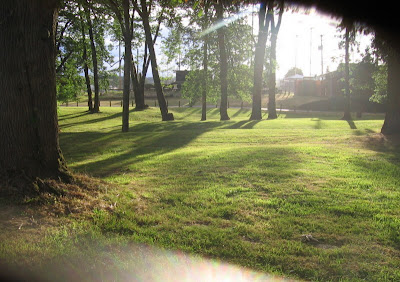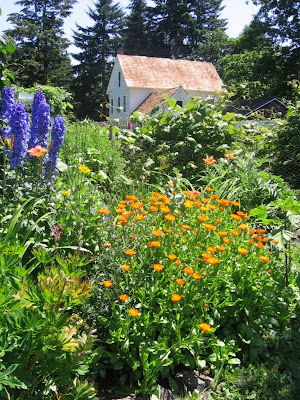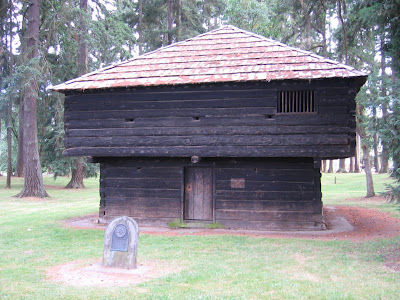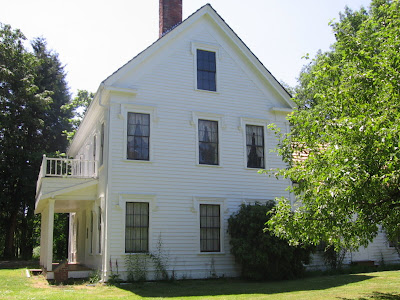

On a recent drive through a local park, Borst Park, My Mom
and I came upon one of our cities most treasured and well
preserved Historical sites. The Historic Borst Home. I've
always known about this Home and knew it was nearby,
but never actually put the pieces together in my mind as to
exactly WHERE it was or how CLOSE. I didn't actually
realize it was located in the actual Borst Park, down a little
paved lane, slightly off from the main part of the park.
and I came upon one of our cities most treasured and well
preserved Historical sites. The Historic Borst Home. I've
always known about this Home and knew it was nearby,
but never actually put the pieces together in my mind as to
exactly WHERE it was or how CLOSE. I didn't actually
realize it was located in the actual Borst Park, down a little
paved lane, slightly off from the main part of the park.



So, as my Mom and I drove through the park and actually
paid attention to the signs, we spotted the directions to the
house and headed straight for it. Now I've been to this park
many a time and never imagined that at the end of the lane
we were on, we would come upon THIS...
paid attention to the signs, we spotted the directions to the
house and headed straight for it. Now I've been to this park
many a time and never imagined that at the end of the lane
we were on, we would come upon THIS...

WE had to stop at the gate and get out and walk down the
drive. We could see a glimpse of the house, but first, on the
right, was a replica of a two room schoolhouse, more on that
in a later post.
drive. We could see a glimpse of the house, but first, on the
right, was a replica of a two room schoolhouse, more on that
in a later post.


Then we came upon the most magnificent display of flower
and vegetable gardens. It was a feast for the eyes, let me tell
you. We were completely shocked and delighted to find this
hidden jewel so close to home and completely unknown to us.
I'll share more on the gardens, a Master Gardner demonstration
in the next post.
and vegetable gardens. It was a feast for the eyes, let me tell
you. We were completely shocked and delighted to find this
hidden jewel so close to home and completely unknown to us.
I'll share more on the gardens, a Master Gardner demonstration
in the next post.

Now, before we continue our tour, let me share a little bit of the
information I've discovered in my online sleuthing about the
Borst Home.
In 1846, a 25 year old Joseph Borst, a New York native, settled
on 320 acres in what is now Centralia. He married Mary
Adeline Roundtree, age 16, in 1954. They began their married
life in a small cabin on Joseph's farm.
During the Indian Wars of 1855-56; they moved ...
information I've discovered in my online sleuthing about the
Borst Home.
In 1846, a 25 year old Joseph Borst, a New York native, settled
on 320 acres in what is now Centralia. He married Mary
Adeline Roundtree, age 16, in 1954. They began their married
life in a small cabin on Joseph's farm.
During the Indian Wars of 1855-56; they moved ...

HERE





To a blockhouse stockade at Fort Hennes, which no longer
exists. The blockhouse was constructed by the Military at the
junction of the Skookumchuck and Chehalis Rivers. Logs were
cut on the south side of the river, hauled to the stream by
Joseph Borst with an ox team, floated across the river, and
then peeled, scored and hewed. The near perfect dovetail
corners and close fitting sides are a testimonial to the skill of
pioneer axeman since nothing more than axes were available
to shape the logs.
exists. The blockhouse was constructed by the Military at the
junction of the Skookumchuck and Chehalis Rivers. Logs were
cut on the south side of the river, hauled to the stream by
Joseph Borst with an ox team, floated across the river, and
then peeled, scored and hewed. The near perfect dovetail
corners and close fitting sides are a testimonial to the skill of
pioneer axeman since nothing more than axes were available
to shape the logs.

The blockhouse never actually had to be used for the
protection of the pioneers; it was used to store fresh water
and grain brought down the Chehalis River by Indians and
others in dugout canoes.
After the war, Joseph bought the blockhouse from the
Government for $500. It was used twice as a residence.
In 1857, James Smith lived in the blockhouse while he rented
the Borst family farm. Joseph and Mary lived there in the
early 1860's while Joseph began to build Mary's dream house.
It was at this time that the windows and the door on the
upper level were added. Previously it had no windows and
only one door.
protection of the pioneers; it was used to store fresh water
and grain brought down the Chehalis River by Indians and
others in dugout canoes.
After the war, Joseph bought the blockhouse from the
Government for $500. It was used twice as a residence.
In 1857, James Smith lived in the blockhouse while he rented
the Borst family farm. Joseph and Mary lived there in the
early 1860's while Joseph began to build Mary's dream house.
It was at this time that the windows and the door on the
upper level were added. Previously it had no windows and
only one door.



Continued erosion over the years of the riverbank endangered
the safety of the blockhouse so it was moved to Rotary
Riverside Park around 1915. Then in 1919, the city
purchased the Borst Park acreage from the Borst family and
the blockhouse was moved to it's present location, near the
entrance of the Borst Park, where it was restored.
Today efforts are underway to relocate the blockhouse to it's
original site near the Historic Borst Home.
the safety of the blockhouse so it was moved to Rotary
Riverside Park around 1915. Then in 1919, the city
purchased the Borst Park acreage from the Borst family and
the blockhouse was moved to it's present location, near the
entrance of the Borst Park, where it was restored.
Today efforts are underway to relocate the blockhouse to it's
original site near the Historic Borst Home.

As we continued down the drive, we see more glimpses of
Mary's dream house. I'm sure it was worth the two year wait
as she saw her completed home for the first time and finally
got to move in, away from that dark block of a house she
had to live in while she waited.
Mary's dream house. I'm sure it was worth the two year wait
as she saw her completed home for the first time and finally
got to move in, away from that dark block of a house she
had to live in while she waited.


Here she is. The Dream. A Stately White home that was once
considered the finest in many a mile. The three story house was
built from plank construction with seasoned timber from
Tumwater, wooden pegs and a soapstone fireplace, which
still stands, and green shutters at the windows.
considered the finest in many a mile. The three story house was
built from plank construction with seasoned timber from
Tumwater, wooden pegs and a soapstone fireplace, which
still stands, and green shutters at the windows.

The front of the house. The Chehalis River in the picture below,
sits to the left (photographer's left) of the home and to the right
(photographer right) lie lots and lots of a green yard, leading
to the main part of the Borst Park.
sits to the left (photographer's left) of the home and to the right
(photographer right) lie lots and lots of a green yard, leading
to the main part of the Borst Park.


Sadly, this was not only a home full of joy, but sorrow as well.
Five of the Borst children died very young, from infancy to age
two.
Five of the Borst children died very young, from infancy to age
two.

A picket fence marks the place where they were originally laid
to rest, but Mary later had them moved to the Mountain View
Cemetery.
to rest, but Mary later had them moved to the Mountain View
Cemetery.


This is the monument I believe Mary may have put up in the
cemetery when she had the children moved. All the names of
the deceased children and their birth/death dates cover the
four sides.
cemetery when she had the children moved. All the names of
the deceased children and their birth/death dates cover the
four sides.

I think the following three stones are the actual markers for
the burial sites of the children. This stone is for either Clara
or Calista and Minnetta. These three markers lie directly
below the monument.
the burial sites of the children. This stone is for either Clara
or Calista and Minnetta. These three markers lie directly
below the monument.

This marker would be for Salucius and again, either Calista or
Clara.
Clara.

This is the last flat marker in the grouping and I'm guessing
it's for the unnamed infant son that died. I'm not sure who
the extra set of initials belong to.
it's for the unnamed infant son that died. I'm not sure who
the extra set of initials belong to.
 This monument is for Joseph and Mary. They were buried
This monument is for Joseph and Mary. They were buriedhere with their children that passed before them. There are
also a few other Borst headstones that come later, but I
could not find any information as to how they were related.

Joseph Borst
Born
Schoharie County,
New York
October 15, 1821
Died
Oct. 29, 1885
 Mary A. Borst
Mary A. BorstBorn
Knox County,
Illinois
June 1,1838
Died
Feb. 18, 1928

Back at the Homestead
The yard, to the left of the Borst home. My niece found her
way into the shot.
way into the shot.

 My Mom and my two of my nieces, the Princesses Cowgirl
My Mom and my two of my nieces, the Princesses Cowgirland Pixie, respectively. They are picking a leaf from this
beautiful green tree whose leaves were like velvet.

The right side of the house, all the rooms from this house would
have had a beautiful river view.
have had a beautiful river view.
 The back of the house. Mary's kitchen is the one story level on
The back of the house. Mary's kitchen is the one story level onthe left. In 1921 (or 1919, I found 2 different dates for this) the
city of Centralia bought the Borst Home for $20,000 and
later obtained the surrounding 101 acres.
The home was renovated in the 1970's and is one of our area's
most authentic and well preserved Historical Sites, including
many of the home's original furnishings.
My Mom and I went back on the 4th of July, they were giving
free tours, but they were only giving glimpses into rooms
for the occasion. We did get to peek into all the downstairs
rooms, including the kitchen,and the pass through room
where they took the food before they served it in the dining
room. The dining room is also known as the fireplace room,
so named for the previously mentioned soapstone fireplace,
which is huge. I imagine it was VERY grand for that time
and place. I would think most fireplaces were made from
stones or possibly brick. WE also saw the "washroom" that
was added for Mary after Joseph's death. The parlor was a
bit dark, but you could see the grandeur it once held, with the
view of the river. The best part, the E carved into the wooden
banister leading upstairs. I believe the guide said it belonged to
one of the Borst children, little Emily who found a creative place
to practice her letters.
We plan to go back this weekend when they have their
regular tour where you get to see the house and schoolhouse
in it's entirety, except for the third story attic. I'm hoping to
be able to take pictures to share with you, but as it's a Historic
place, I'm not sure if cameras are allowed. I HOPE so!


18 comments:
Oh Sares, this is very interesting. Thank you for taking the time to give us the history. How sad that 5 of their children all died so young and what a lovely home, too bad the children did not enjoy it much...Christine
Wow! That is really cool! I enjoyed all the history of the house. It is such a cute house, and I hope you can get pictures when you go back!
Sares that was extremely interesting and beautiful grounds. I love it, like an online field trip with your great photos and research. I'm sure they'll let you take pictures when you get to go inside. (hopefully for us) ;) I'm so fascinated by sites like that and drag my husband and kids every chance I get to visit a new one. lol!
♥ Teresa
Oh wow, what a story this is. I loved reading a piece of story/history shared in this post. My, from humble beginnings to transferring to a dream home. What a difference it is.
But the block house sure looks interesting. Then again, Mary surely enjoys the new home where she and her husband started family. And I'm sure the vast land with trees, flowers, and veggies was and still a joy to look at.
The small white-fence where Mary's children were originally laid is something. Yes, that must have been real heart wrenching and she didn't want or was ready yet to part with her little darlings then.
Thanks for sharing.
Li
You have just received an award from me!!! Come on over and claim your award!!! :)
What an interesting tour you have given us. I especially love the colorful flowers.
I love seeing about old houses and reading the history of them. Her dream home was so beautiful. I love the moldings on top of the windows. It is very sad though about all of those children dying so young. Back in those days that happened a lot.
Hi Sares! first off, your post was really neat I enjoyed reading it my husband will enjoy it too when he gets home from work. He likes history things....Now, I have a cake for you at my blog, come pick it up!! hugs, Jennifer
I grew up in Chehalis. We played in this park all of our youth ... had lovely picnics there. Even our school picnics & events were held here.
Did you see the bullets holes in the Fort?
In the Borst home my g'mas Jadeite Salt & Pepper shakers are in the kitchen & her carpet is on the floor.
You captured this beautifully. Wow! Memories are flooding back.
TYSM for sharing this.
TTFN ~Marydon
Thanks for the history lesson! Fun post!
Awesome jot back through history. I love stuff like this! The house and the property is unbelievably beautiful!
My cousins for years lived on & were the caretakers of the properties at Ft. Borst. I'd appreciate it if you see the jadeite shakers & carpet to take a picture of them for me. That would fill my heart immensely. These items were, FYI to share with them, given by Mary C. Middaugh in honor of & from the estate of her Mother ~ Maggie Carty Neu, when we closed down the family home.
What town do you live in again?
DH has to see this post when he comes in. TTFN ~Marydon
Sares! How are you!this is very interesting, thanks for sharing this history, but How sad that 5 of their children all died so young.
just beautiful house, my house looks like this house.
xoxo
Marina
Hi Sares!
Marydon gave me the head's up on this great post...I LOVE the history of it and will try to make it there for a visit sometime soon. Don't you wish the walls could talk?
You did a great job telling the story...
Hugs,
Spencer
thank you Sares for taking us on a great trip out.
I love history and enjoyed seeing your photos of the house and hearing all about this place and the people that lived there.
Hugs
Carolyn
Awesome!! I loved it! I love visiting places like this!
Hugs, Lisa
Thank you Sares...after the tour was over I was like.."Hey! I don't want it to end!" Bummer! I really enjoyed it and I read it aloud to my DH. We loved the picture of the trees with the sunbeams shining through them. Loveleigh!
Hugs,
Deanna :D
Wow...never knew that was there either...although every child in the county has been to the fort! Quite the LOVELIEGH treasure you found!!!
Post a Comment